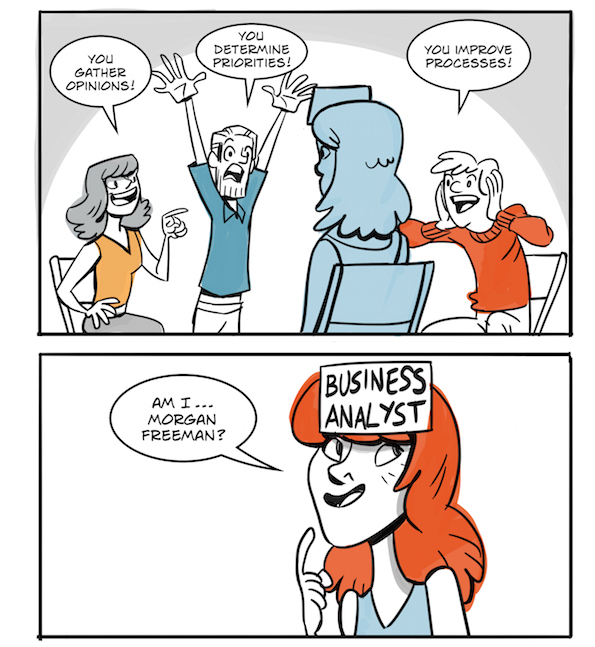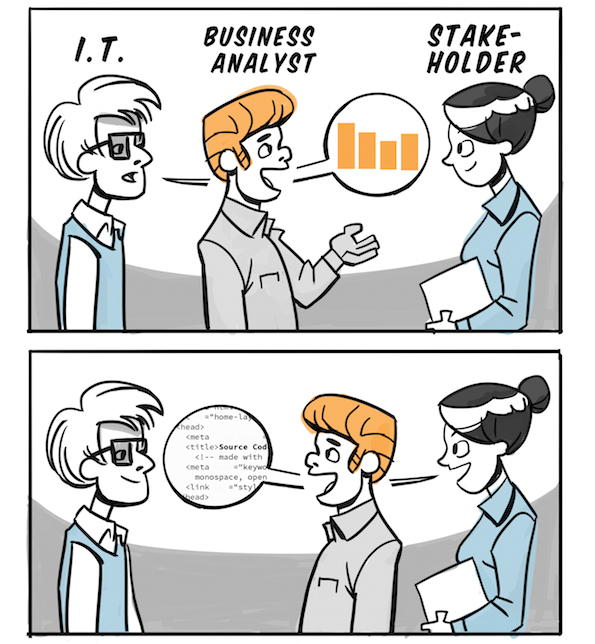As a business analyst, I’m regularly asked what it is that I do. Often I’ll need to take a moment to articulate my job and my explanation always manages to sound a little ambiguous.
If you’re a business analyst like me, I’m sure you’ve also been faced with the same question at a dinner, BBQ or corporate event. The problem is, guidebooks rarely provide a clear answer – and good luck trying to find a consistent explanation on Google!
So why is there such a general lack of understanding around what a business analyst does (sometimes even for business analysts themselves)? After careful consideration and some soul searching, I think I’ve found a few answers:

After careful consideration and some soul searching, I think I’ve found a few answers:
Business analysts help facilitate solutions for stakeholders
When a business needs to solve a current or future problem it’s a business analyst’s job to help facilitate a solution.
Mainly we help by working with stakeholders to define their business needs and extract their requirements for what must be delivered. We gather the business’ required conditions and capabilities, documenting them in a consistent, complete and, above all, useful way for the team that will eventually design and deliver the solution.
One of our main responsibilities is to ensure these requirements are visible to, and understood by, all relevant stakeholders regardless of whether the solution is a new product, service or computer system.
We do this by writing clear requirements and creating data models, process diagrams and design wireframes that will further support the business’ needs. We’ll also determine what additional information is necessary, what key details are missing and the potential impacts and challenges to the solution and/or other projects.
Business analysts offer guidance and advice on what requirements and solutions will best fit a business’ needs, now and into the future. Working closely with key business decision makers as well as development and testing teams, we ensure the solution developed will meet the business’ requirements in an acceptable and sustainable way.
Business analysts aren’t limited to one task or activity
One of the reasons it’s so difficult to explain exactly what a business analyst does is because we never perform just the one task.
We’ll often wear many hats as our tasks, activities and responsibilities are always changing. Here are just a few of the things we might do in any given day:
- Analyse business needs
- Define a business case
- Elicit information from stakeholders
- Model requirements
- Validate solutions
- Project management
- Project development
- Quality testing
What a business analyst ‘does’ greatly varies depending on what project he or she is working on, what stage of the project they’re in, the stakeholders involved or even the organisation itself.
It’s not just about the title business analyst
It’s important to note that you don’t have to be called a ‘business analyst’ to do what a business analyst does.
Many perform business analyst activities as part of their existing role – data analysts, process analysts, change managers and user experience specialists all typically exhibit business analyst behaviour.
In fact, if you’ve ever worked on a small project where a business analyst wasn’t ‘technically’ involved, think again – it might have been you!

For instance, if your department needed a software solution, perhaps you:
- Spoke with your team about what everyone required the new software to do?
- Asked how it should look and behave?
- Prioritised what was needed by determining ‘must haves’ and ‘nice to have’?
- Communicated these requirements to your IT team?
- Clarified any IT issues or questions to provide more insight into delivery specifications?
Or perhaps in the course of your work you’ve:
- Discovered inefficiencies/waste in an existing process?
- Determined ways to improve a process?
- Implemented change?
- Tracked the results of change and measured its value to your organisation?
If any of the above sounds familiar, congratulations! You were doing what a business analyst does!
Business analysts are information conduits
Every project I’ve worked on has encompassed a wide and varied range of stakeholders – from managers to end users, vendors to customers, developers to testers, subject matter experts, architects and more.
All these stakeholders have different needs, goals and knowledge of the business. So it’s my job to bring all this knowledge together, analyse the information gathered and provide a clear understanding and vision for everyone to work with. I’m also inherently responsible for bridging the gap that exists between IT and the business.
I often compare business analysts to interpreters. Like translating French into English, we translate our business stakeholders’ needs into a language their IT or development team can understand.
Vice versa, we’ll interpret tricky IT questions and technical complexities for our business stakeholders in a way that makes more sense to them – so they can decide on how best to move the project forward.

The final analysis
I hope these thoughts have helped explain what a business analyst actually does, or given you a way to definitively answer curious questions at that next BBQ.
While the tasks we do and the projects we work on will always vary, one overlapping theme remains – a business analyst helps facilitate a business to implement change.
We use our various skills, tools and techniques to clarify and define a business problem or opportunity, then work closely with all stakeholders to develop a solution that fully meets the business’ needs, today and tomorrow.
Suggested reading:
- My Job Title Is Not Business Analyst, But Am I One?
- Explaining Business Analysis To Laypersons, Including Ourselves


